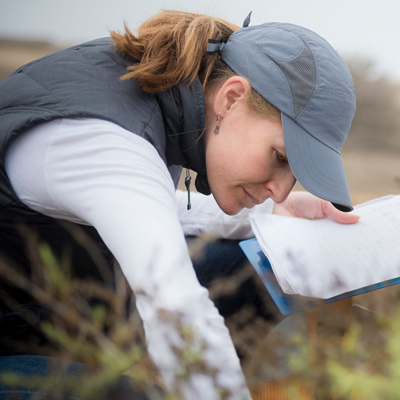Understanding ecosystems to design creative approaches to restoration
The cost to control invasive species and the damages they inflict upon property and natural resources in the US is $137 billion each year. These invasive plants, animals, or other organisms are introduced to an area outside of their original range and cause incredible harm to their new environment. In fact, invasive species are recognized by many scientists as one of the leading threats to biodiversity -- an important tenet of life as we know it. Dr. Elsa Cleland, an Associate Professor in the Ecology Behavior & Evolution Section at the University of California, San Diego, studies the impacts of environmental change on species and ecosystems, including invasive species. With the hope to not only understand ecosystems’ and species’ responses but also to design scientific-based strategies to help protect them, Dr. Cleland and her team use a variety of creative approaches to bring the science of restoration to life.
Working specifically in California, a “hot-spot” both for current biodiversity and predicted future climate change, Dr. Cleland studies the wonderfully diverse plant communities to understand both short term changes in species abundance and also long term evolutionary potential of species to adapt to these changes. Thus, her research helps to protect our natural resources by understanding how they function in addition to contributing to incredible efforts in restoration and conservation applications. While many researchers study model systems because they are easy to manipulate, Dr. Cleland is focused on performing large-scale experiments in diverse natural systems to gain realism. In so doing, she and her team are able to delve into the mechanistic basis of responses with follow-up smaller scale, controlled experiments. Therefore, she can make generalizations that go beyond ecosystems in Southern California to understand how many ecosystems worldwide are likely to respond to the myriad of environmental changes occurring today.
Current projects include:
-
Drought: Native species and invasive species are functionally quite different from one another. Often, invasive species grow faster and have a shorter lifespan than native species in addition to decomposing more quickly. Dr. Cleland and her team are investigating how these differences between invasive and native species impact droughts. Similarly, her research investigates the shifts in rainfall that may affect invasive or native species. With a greater understanding, she hopes to respond to environmental concerns like fires and subsequent restoration.
-
Climate Change: Research in Dr. Cleland’s lab has suggested that invasive species in California are active earlier in the growing season than native species. Because they can grow earlier, the effects of climate change can cause them to have an even longer growing cycle. By examining the timing for invasive and native species, Dr. Cleland can make strides towards solutions for combatting climate change.
-
Evolutionary Potential: A new direction in Dr. Cleland’s lab is investigating the many species that exist across wide environmental gradients. She and her team believe that there may already be genetic potential along the ends of that gradient to represent ways for species to respond to future climate change. By harnessing the tools species have already developed, Dr. Cleland may be able to restore ecosystems that are resilient to future climate change.
Bio
Dr. Elsa Cleland is an Associate Professor in the Ecology, Behavior & Evolution Section at the University of California, San Diego. When she looks at an ecosystem, she is amazed by the “connections among the various species and the environmental factors, like a big three-dimensional web.” By “pushing on that web,” she explains, through natural disturbances like fire or human-caused changes in climate, some species will do well while others will have a hard time. Thus, she is motivated to understand these complex natural systems in order to predict how they will respond to the suite of environmental changes occurring today.
Growing up Dr. Cleland spent many happy days pondering the plants and ecosystems in her native Wisconsin, and her fascination with natural systems drew her to a career in ecology. She explored many habitats in her studies, including the eastern forests near Duke University as an undergraduate student, coral reefs in the Florida Keys and Australia, the Alaskan tundra, the Sonoran Desert of Arizona and even the rainforest in Kenya. When she pursued her Ph.D. at Stanford University she discovered the exceptionally diverse flora of California, and focused her research around the response of these communities to climate change.
A firm believer in the power of natural systems to inspire, Dr. Cleland works to expose the complexity of natural work through teaching and outreach as well as research. Dr. Cleland is the Director of the UC San Diego Natural Reserves, the founder of the UC San Diego Undergraduate Ecology, Behavior & Evolution Club, and since 2008 she has involved more than 65 undergraduate students in research in natural areas of Southern California. In her free time, she also enjoys spending time outdoors with her two children, and showing them the many fascinating species that she works to protect.
Website: http://labs.biology.ucsd.edu/cleland/cleland/Home.html


